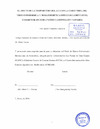Identificador persistente para citar o vincular este elemento:
https://accedacris.ulpgc.es/jspui/handle/10553/76885
| Título: | El efecto de la temperatura del agua en la carga viral del virus hypodermica y hematopoiética infeccioso (IHHNV) en el camarón blanco del Pacífico (Litopenaeus vannamei) | Otros títulos: | The effect of water temperature on the viral load of infectious hypodermal and hematopoietic necrosis virus (IHHNV) in the Pacific white shrimp Litopenaeus vannamei | Autores/as: | Montgomery-Brock, Dee | Director/a : | Tacon, Albert | Clasificación UNESCO: | 310502 Piscicultura 3109 Ciencias veterinarias |
Palabras clave: | Litopenaeus vannamei IHHNV |
Fecha de publicación: | 2006 | Resumen: | lnfectious Hypodermal and Hematopoietic Necrosis Virus (IHHNV) is a senous pathogen, which for the last 24 years has been responsible for negatively affecting the growth and survival of cultured Penaeid shrimp, in particular the Pacific white shrimp, Litopenaeus vannamez. Previous studies have determined that warm water culture conditions inhibit the replication rate of two other important shrimp viruses, including White Spot Syndrome Virus (WSSV) and Taura Syndrome Virus (TSV) in L. vannamei. The purpose of this study was to compare the eff ect of water temperature on the replication rate of IHHNV in shrimp held in warm water, compared to the replication rate of IHHNV in shrimp held in cold water. A total of 72 Specific Pathogen Free (SPF) Litopenaeus vannamei were used for this study. They were divided into four groups, namely 1) saline injected shrimp held in warm water (>30 ºC), 2) saline injected shrimp held in cold water ( <27 ºC), 3) IHHNV injected shrimp held in warm water (>30ºC), and 4) IHHNV injected shrimp held in cold water (<27 º C). The concentration of IHHNV in shrimp collected from Dayl - Day 17 post-exposure were measured with real time Polymerase Chain Reaction (PCR) using the TaqMan® technique. The results from samples collected Day 6, 12, and 17 post-exposure showed a significant difference (p<0.05) between the viral load of the IHHNV injected shrimp held in shrimp held in the warm water conditions averaged counts of 1,439, 1,767, and 119,960 virus/50 ng of shrimp tissue on days 6, 12, and 17 respectively. The IHHNV exposed shrimp in the cold water conditions averaged counts of 225,208, 1.8 million, and 4.6 million virus/50 ng on days 6, 12, and 17 respectively. These results clearly indicate that under the conditions in the tria!, water temperature had a profound effect on the replication rate of IHHNV in L. vannamei. The results support the findings of previous studies and further point to the potential application of elevated environmental temperature as a management strategy within the shrimp farming industry, as maintaining water temperatures above 30 ºC will help to protect shrimp from viral infections. | Facultad: | Facultad de Ciencias del Mar | URI: | https://accedacris.ulpgc.es/handle/10553/76885 |
| Colección: | Trabajo final de máster Restringido ULPGC |
En el caso de que no encuentre el documento puede ser debido a que el centro o las/os autoras/es no autorizan su publicación. Si tiene verdadero interés en el contenido del mismo, puede dirigirse al director/a o directores/as del trabajo cuyos datos encontrará más arriba.
Vista completaVisitas
78
actualizado el 24-ago-2024
Descargas
19
actualizado el 24-ago-2024
Google ScholarTM
Verifica
Comparte
Exporta metadatos
Los elementos en ULPGC accedaCRIS están protegidos por derechos de autor con todos los derechos reservados, a menos que se indique lo contrario.
